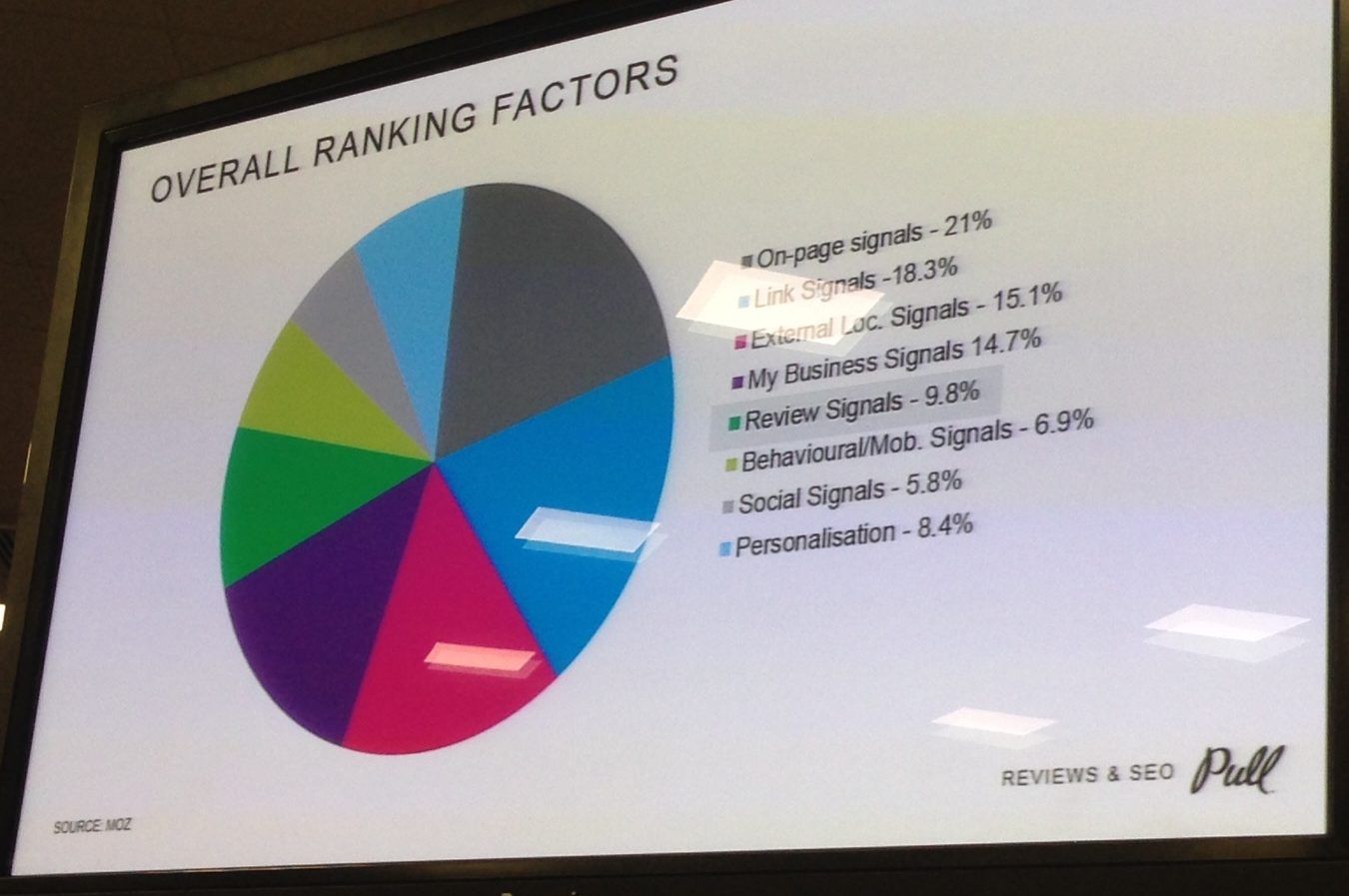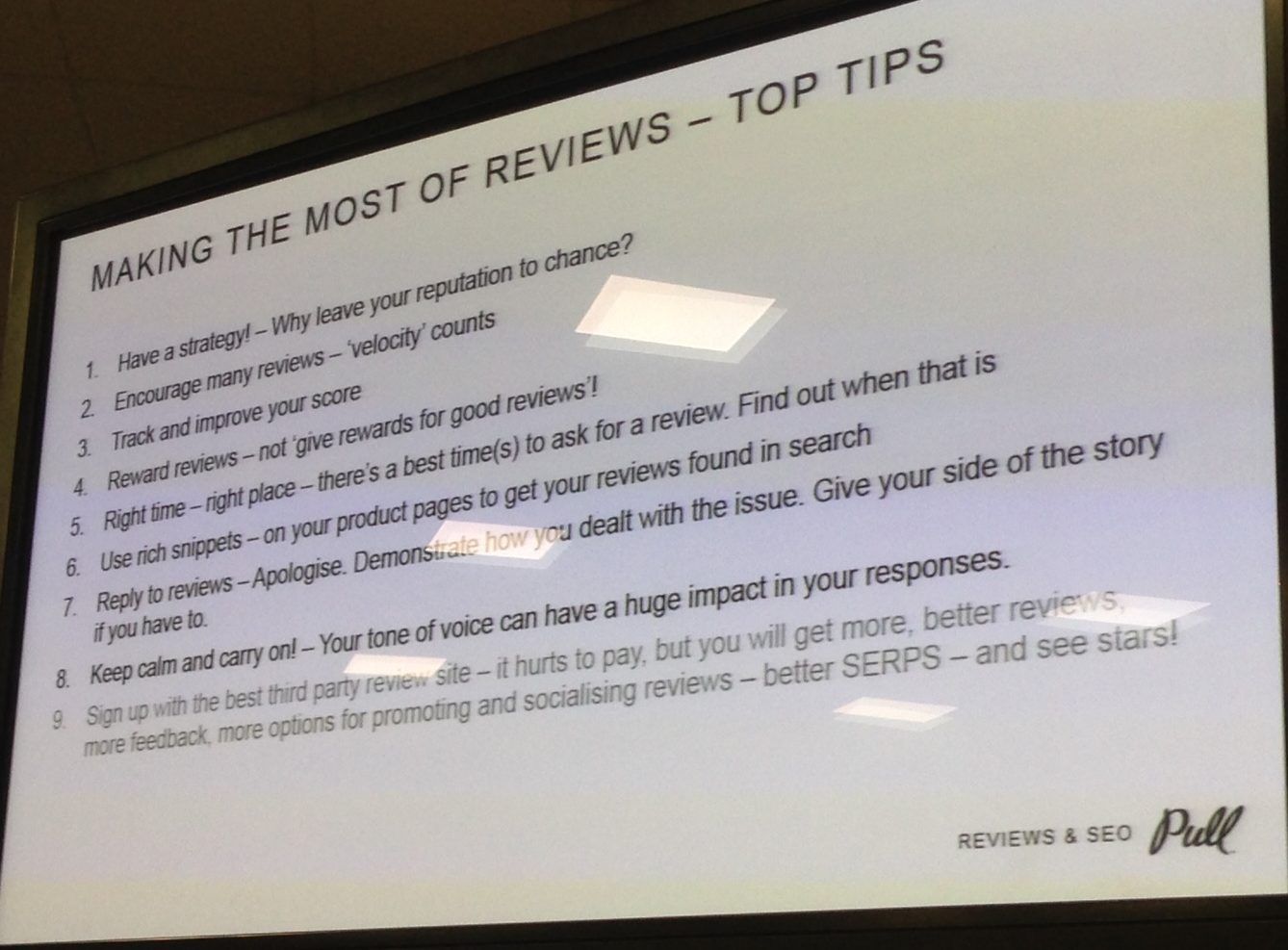Chris Bullick, Managing Director & Head of Marketing Services for Pull Digital, delivered an interesting presentation at Brighton SEO last week about how reviews can affect purchasing decisions and what this means for SEO.
When we discuss the idea of adding reviews to a brand’s strategy, here are the most persuasive stats to support the decision:
- 90% of consumers read reviews before visiting a business
- 31% of customers are likely to spend 31% more on a business with excellent reviews
- Reviews can boost your results by using fresh user-generated content
- 72% of consumers will take action only after reading a positive review
“88% of consumers trust online reviews like personal recommendations” – on reviews and SEO #BrightonSEO
— Search Engine Watch (@sewatch) September 2, 2016
Google’s ranking factors are changing all the time and there seems to be an increasing focus on content, uniqueness, device friendliness and social sharing.
Thus, every new piece of content should be:
- Unique (appears nowhere else on the web)
- Relevant (contains content that engines can interpret as on-topic),
- Helpful (resolves the searcher’s query in a useful and efficient manner)
- Uniquely valuable (provides information that’s unavailable elsewhere)
- Offers great UX (is easy and pleasurable to consume on any device)
- Likely to spread (convincingly answers the question ‘who would amplify this content and why?’)
It is estimated that review signals account for 9.8% of the total ranking factors, which means that they cannot be ignored during SEO, especially if a brand can benefit from their use.
Six ways reviews can help SEO
Creates fresh user-generated content
Content is never enough and reviews make a great form of user-generated-content, coming directly from users – which is more influential for future customers.
What’s more, it’s a great form of relevant content and they should always be encouraged.
Boosts long-tail (Read more...) traffic
As reviewers are buyers of your products, the language they use is similar to the one your target audience will use. Thus, the consistent flow of reviews will help you target more traffic through the right keywords, coming directly from your own customers.
Boosts social conversation
What if a series of impressive reviews helps your product become popular, increasing both the social reach, but also the sales? How about incorporating reviews to your social strategy as a way to prove the love for your products.
Google favours highly-rated sites
Google takes into consideration the rating of sites, favouring those having the highest ratings. It’s your social proof and authority that reviews can boost, which means that it’s not just about adding reviews to your site, you should also to focus on how to improve them.
Receive visible star ratings
When star ratings are displayed in Google search results, prospective customers can instantly judge whether they can trust your product enough to visit your site. This helps increase the traffic, and possibly the sales, but it’s not always easy to achieve it.
Google relies on specific third-party review sites to determine your star rating. You should have at least 30 unique reviews during the past year, with an average of 3.5 or higher.
Star ratings may lead to an increased conversion rate of up to 17%, which is a great incentive to research more about them, along with Google’s guidelines on how to be eligible.
Improve ranking for products
As more people start searching for the reviews of your products, there will be more opportunities to rank higher in SERPS, increasing the chances of seeing more searches in the form of [product name] + review.
This may serve as an additional opportunity to reach your potential audience in the most relevant way: right when they are searching for more details about your products.
How to make the most of reviews
According to Chris Bullick, here are the best ways to use reviews for your brand’s strategy:
- Have a strategy. You don’t want to leave your brand’s reputation to chance.
- Encourage reviews. There are many ways to encourage more reviews, whether it’s through the site, email campaigns, or social media. Keep asking for them, new reviews are always welcome.
- Track and improve your score. It’s not just about gaining new reviews, but also about improving your ratings to increase the conversion rate. A closer communication with customer service would help you understand what customers want from your products, trying to improve it, aiming for better reviews.
- Reward reviews. As you are seeking more reviews, a reward may be useful for your customers, but still, don’t try too much by providing too many rewards.
- Right time – right place. Not every time and place is suitable when asking for reviews, especially when taking into consideration the purchase journey. Make sure you are targeting the right audience (customers) when asking for reviews, rather than a generic audience that may include one-time visitors.
- Use rich snippets. Rich snippets on your product pages may help your reviews show up in search results, provided they include the right information for your products to help Google trace them.
- Reply to reviews. Reviews are still part of your communication with your customers, so even the worst review needs to be answered. Always apologise to a disappointed customer and be ready to help if possible.
- Keep calm and carry on. Set a tone that reflects your brand and stick to it. Keep in mind that the tone has to be polite and helpful, but it may still be authentic, enhancing the customer experience when needed.
- Sign up with the best third party review site. As Google relies on third party review sites to determine a site’s reviews, it may be a good idea to learn more about these sites, working towards building your reputation, leading to better SERPs.
- Don’t forget Facebook ratings. Your review strategy should not ignore reviews on social media, especially on Facebook, where many users flock to learn more about a brand, or a product.
- Embrace bad reviews Negative reviews are still important for your review strategy, as they tend to be the most sought out and read by users. Keep monitoring them to improve your customer experience, be ready to respond, and never delete them or hide them.
Related reading
I’ve often looked at bounce rates and associated metrics as a way to measure the general stickiness and appeal of a website. ... read more
China is a world leader when it comes to social commerce. Here, JD.com's Joey Bian outlines how cosmetic giant SK-II blended data from two of China's biggest ecommerce and social sites to improve both brand perception and ROI.
The terms that customers type into your site search function can help you to gain an understanding of user behaviour and can be used to optimise ... read more
No matter your industry, field, career, day-to-day responsibilities, or duties, communication is integral to your success. This is particularly true in SEO ... read more







